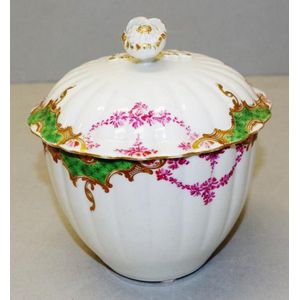Worcester Hand Painted Sucrier with Garland Decoration
Antique Worcester hand painted lidded sucrier hand painted garland decoration, flower knop to lid. circa 1770, diameter 10.5 cm height 13 cm
You must be a subscriber, and be logged in to view price and dealer details.
Subscribe Now to view actual auction price for this item
When you subscribe, you have the option of setting the currency in which to display prices to $Au, $US, $NZ or Stg.
This item has been sold, and the description, image and price are for reference purposes only.
- Floral Swag / Garland / Festoon - Floral swags are a decorative motif often used in the ornamentation of various objects, such as silverware, glassware, and furniture. The term "swag" refers to a garland or wreath of flowers, foliage, or other decorative elements, which is usually arranged in a loop or curve.
Floral swags can be found in a variety of decorative styles, from ornate Baroque and Rococo designs to more naturalistic Art Nouveau and Art Deco styles. They are often used to add a touch of elegance, refinement, or whimsy to an object, and can be seen on a range of items from chandeliers and candlesticks to picture frames and tea sets.
In the decoration of silver objects, floral swags are often used to accentuate the curves and lines of the piece, and to add visual interest to the surface. Similarly, on glass objects, floral swags may be used to frame or highlight a particular area of the object, or to add a touch of color and delicacy.
On furniture, floral swags can be found on a variety of pieces, from cabinets and armoires to chairs and sofas. They are often used to enhance the lines and curves of the furniture, and can be used to create a sense of movement and flow in the design.
Overall, floral swags are a versatile decorative element that can be adapted to a range of styles and applications, and have been used in the decoration of various objects throughout history. - Knop (ceramics) - In ceramics, a knop is a protuberance on the top of an object, and can be either decorative, or used as a knob to lift the item.
- Circa - A Latin term meaning 'about', often used in the antique trade to give an approximate date for the piece, usually considered to be five years on either side of the circa year. Thus, circa 1900 means the piece was made about 1900, probably between 1895 and 1905. The expression is sometimes abbreviated to c.1900.
This item has been included into following indexes:
-
Worcester (England), item types
- other items 521
- sugar bowls, sucriers 29
Visually similar items

Victorian pink and white cased glass bowl, with hand painted butterfly and leaf decoration, diameter 12 cm
Sold by
in
for
You can display prices in $Au, $US, $NZ or Stg.

A Duesbury Derby sugar basin and cover. 14 cm high, 20 cm long
Sold by
in
for
You can display prices in $Au, $US, $NZ or Stg.

Large Chinese polychrome lidded jar 50 cm high approx
Sold by
in
for
You can display prices in $Au, $US, $NZ or Stg.

A Herend porcelain vegetable tureen, organic shaped double handles, with flowers and butterfly designs, lemon lid finish. Length 21 cm.
Sold by
in
for
You can display prices in $Au, $US, $NZ or Stg.
